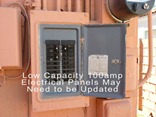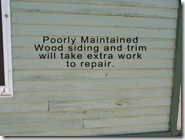Are you thinking about buying a historic home in the Downtown Phoenix area? Those Tudor Revival, Monterrey and Bungalow homes are pretty irresistible, we admit. If buying a historic home is in your dreams, then you’ve come to the right place. We love helping people find a home that has long-term value, isn’t fraught with problems and meets your historic home dreams.
You’ve probably heard horror stories about problems with older homes. Some are true and some aren’t. This article is designed to give insight into some of the major problems associated with older homes. Before we go any further, here’s some quick advice:
- Never buy a home without getting a professional home inspection
- If you are buying an historic property, make sure your professional and licensed inspector has plenty of experience with historic properties
Things to Look at When Buying A Historic Home in Phoenix, AZ
FOUNDATIONS AND LOT GRADES
 A large percentage of historic homes are brick or block construction and many are on raised foundations since the early days in Phoenix saw a fair amount of flooding. Cracks in walls, ceilings and stem walls are a sign of both old and new problems.
A large percentage of historic homes are brick or block construction and many are on raised foundations since the early days in Phoenix saw a fair amount of flooding. Cracks in walls, ceilings and stem walls are a sign of both old and new problems.
Often, we see where previous homeowners put flowerbeds up against the home and water from them is causing ongoing settling and movement of the ground. Poor grading of the lot can cause the same destabilization problems as water is moved towards the foundation of the home and not away from it.
Ceiling and wall cracks, hard-to-close doors and windows, sloping floors and uneven walls are all possible signs of foundation issues.
ELECTRICAL
Modern day demand for power is very different from what it used to be. Today we like 200 Amp service, 3-wire electric circuits, fully grounded receptacles, lots of outlets and ground fault interrupters in kitchens, baths and laundry areas.
If you buy a home that hasn’t been professionally updated, it’s not the end of the world. All things are possible with time and money. We strongly recommend you get a couple of bids from historic knowledgeable electricians during your inspection period so that you know what is involved to bring the home to current standards.
There are a lot of variables that can affect retrofit costs such as lath and plaster walls, need to replace 2 wire runs with modern 3 wire circuits, poor quality pre-existing repairs and more.
PLUMBING
The most common plumbing problem with historic homes is galvanized piping. Older galvanized pipe has a reputation for leaking and clogging. The problem with leaks is self-explanatory – clogging can cause low flow to faucets, showers and other parts of the home.
At some point, most historic homes should be retrofitted with copper pipe. Re-piping an historic home can be more difficult than newer homes because of lath and plaster construction. Let’s just say that drywall is a lot easier to work with than lath and plaster.
Just as an FYI, plumbers do not generally fix the walls they cut open during a re-piping job. Make sure and include the price of repairing walls and repainting to the overall project budget.
WOOD & PAINT
Wood trim and accents – both interior and exterior – are often a significant architectural feature in historic homes. The exposed woodwork of the Tudor Revival, the porch rails of a Bungalow, crown moldings, arts & crafts door trim and more add to a home’s value and distinction.
The care and maintenance of a home’s wood is important; failure to do so can be costly. Paint is another place to pay attention. Some homeowners have dutifully stripped off old paint to bare wood and start fresh; this is ideal. Take care when removing old paint in an older home because it’s typically lead-based. Again, this isn’t an insurmountable problem as long as proper care is taken or you hire a professional with the right skills and knowledge.
MESSED UP BEYOND RECOGNITION
This is kind of a strange and subjective area, but we feel passionate about it. Some historic homes have really been messed up. FUBAR is probably a good term here. We’ve seen room additions so bad they should be torn down. Many times we see where prior owners have taken the historic out of the home, i.e.:
- Vintage hardware removed and replace with Home Depot’s cheapest
- Cheesy “track home” cabinets in kitchens and baths
- Synthetic flooring over original wood floors
- Period correct door trim, baseboards and other wood finery replaced with the cheapest stuff they could buy at a box store
- Modern doors replacing the style used back in the day
- Not-to-code window replacement (A home in a designated historic district must go through approvals prior to changing exterior elements like windows. It’s not a hard process and it helps keep a home’s historic worth.)
- Room additions using dissimilar building material from the original home (Most often we see a beautiful brick or block home with a room addition made using 2×4 construction and covered with stucco or tacky wood siding.)
Historic homes have inherent value. They have charm, tell a story, and frame a piece of history. The stories and substance are expressed through authenticity, care and passion. When these elements are put into an historic home something special happens; it is a type of magic.
We hope this information about concerns when buying a historic home has been helpful. If you have questions or thoughts, drop us an email at urbanconnection@thecanigliagroup.com or call 602-428-5687.
The Caniglia Group at Realty Executives
7600 N. 16th Street, #100
Phoenix, AZ 85021
602-428-5687



